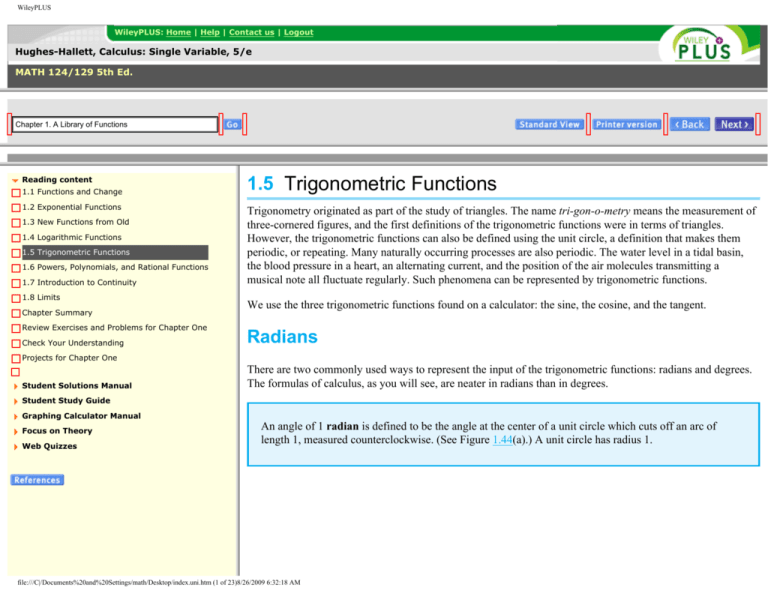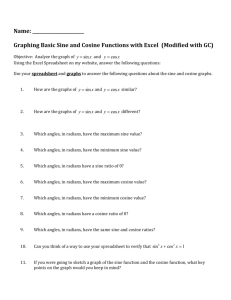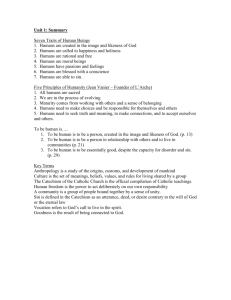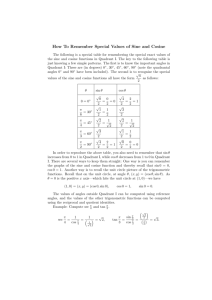
WileyPLUS
WileyPLUS: Home | Help | Contact us | Logout
Hughes-Hallett, Calculus: Single Variable, 5/e
MATH 124/129 5th Ed.
Chapter 1. A Library of Functions
Reading content
1.1 Functions and Change
1.2 Exponential Functions
1.3 New Functions from Old
1.4 Logarithmic Functions
1.5 Trigonometric Functions
1.6 Powers, Polynomials, and Rational Functions
1.7 Introduction to Continuity
1.8 Limits
Chapter Summary
Review Exercises and Problems for Chapter One
Check Your Understanding
1.5 Trigonometric Functions
Trigonometry originated as part of the study of triangles. The name tri-gon-o-metry means the measurement of
three-cornered figures, and the first definitions of the trigonometric functions were in terms of triangles.
However, the trigonometric functions can also be defined using the unit circle, a definition that makes them
periodic, or repeating. Many naturally occurring processes are also periodic. The water level in a tidal basin,
the blood pressure in a heart, an alternating current, and the position of the air molecules transmitting a
musical note all fluctuate regularly. Such phenomena can be represented by trigonometric functions.
We use the three trigonometric functions found on a calculator: the sine, the cosine, and the tangent.
Radians
Projects for Chapter One
Student Solutions Manual
There are two commonly used ways to represent the input of the trigonometric functions: radians and degrees.
The formulas of calculus, as you will see, are neater in radians than in degrees.
Student Study Guide
Graphing Calculator Manual
Focus on Theory
Web Quizzes
An angle of 1 radian is defined to be the angle at the center of a unit circle which cuts off an arc of
length 1, measured counterclockwise. (See Figure 1.44(a).) A unit circle has radius 1.
file:///C|/Documents%20and%20Settings/math/Desktop/index.uni.htm (1 of 23)8/26/2009 6:32:18 AM
WileyPLUS
Figure 1.44 Radians defined using unit circle
An angle of 2 radians cuts off an arc of length 2 on a unit circle. A negative angle, such as -1/2 radians, cuts
off an arc of length 1/2, but measured clockwise. (See Figure 1.44(b).)
It is useful to think of angles as rotations, since then we can make sense of angles larger than 360°; for
example, an angle of 720° represents two complete rotations counterclockwise. Since one full rotation of 360°
cuts off an arc of length 2π, the circumference of the unit circle, it follows that
In other words, 1 radian = 180°/π, so one radian is about 60°. The word radians is often dropped, so if an angle
or rotation is referred to without units, it is understood to be in radians.
Radians are useful for computing the length of an arc in any circle. If the circle has radius r and the arc cuts off
an angle θ, as in Figure 1.45, then we have the following relation:
Figure 1.45 Arc length of a sector of a circle
The Sine and Cosine Functions
file:///C|/Documents%20and%20Settings/math/Desktop/index.uni.htm (2 of 23)8/26/2009 6:32:18 AM
WileyPLUS
The two basic trigonometric functions—the sine and cosine—are defined using a unit circle. In Figure 1.46, an
angle of t radians is measured counterclockwise around the circle from the point (1, 0). If P has coordinates (x,
y), we define
We assume that the angles are always in radians unless specified otherwise.
Figure 1.46 The definitions of sin t and cos t
Since the equation of the unit circle is x2 + y2 = 1, we have the following fundamental identity
As t increases and P moves around the circle, the values of sin t and cos t oscillate between 1 and -1, and
eventually repeat as P moves through points where it has been before. If t is negative, the angle is measured
clockwise around the circle.
Amplitude, Period, and Phase
The graphs of sine and cosine are shown in Figure 1.47. Notice that sine is an odd function, and cosine is even.
The maximum and minimum values of sine and cosine are +1 and -1, because those are the maximum and
minimum values of y and x on the unit circle. After the point P has moved around the complete circle once, the
values of cos t and sin t start to repeat; we say the functions are periodic.
file:///C|/Documents%20and%20Settings/math/Desktop/index.uni.htm (3 of 23)8/26/2009 6:32:18 AM
WileyPLUS
For any periodic function of time, the
• Amplitude is half the distance between the maximum and minimum values (if it exists).
• Period is the smallest time needed for the function to execute one complete cycle.
Figure 1.47 Graphs of cos t and sin t
The amplitude of cos t and sin t is 1, and the period is 2π. Why 2π? Because that's the value of t when the
point P has gone exactly once around the circle. (Remember that 360° = 2π radians.)
In Figure 1.47, we see that the sine and cosine graphs are exactly the same shape, only shifted horizontally.
Since the cosine graph is the sine graph shifted π/2 to the left,
Equivalently, the sine graph is the cosine graph shifted π/2 to the right, so
We say that the phase difference or phase shift8 between sin t and cos t is π/2.
Functions whose graphs are the shape of a sine or cosine curve are called sinusoidal functions.
file:///C|/Documents%20and%20Settings/math/Desktop/index.uni.htm (4 of 23)8/26/2009 6:32:18 AM
WileyPLUS
To describe arbitrary amplitudes and periods of sinusoidal functions, we use functions of the form
where |A| is the amplitude and 2π/|B| is the period.
The graph of a sinusoidal function is shifted horizontally by a distance |h| when t is replaced by t - h or
t + h.
Functions of the form f (t) = A sin (Bt) + C and g(t) = A cos (Bt) + C have graphs which are shifted
vertically and oscillate about the value C.
Example 1
Find and show on a graph the amplitude and period of the functions
(a) y = 5 sin(2t)
(b)
(c) y = 1 + 2 sin t
Solution
(a) From Figure 1.48, you can see that the amplitude of y = 5 sin(2t) is 5 because the factor
of 5 stretches the oscillations up to 5 and down to -5. The period of y = sin(2t) is π,
because when t changes from 0 to π, the quantity 2t changes from 0 to 2π, so the sine
function goes through one complete oscillation.
(b) Figure 1.49 shows that the amplitude of y = -5 sin(t/2) is again 5, because the negative
sign reflects the oscillations in the t-axis, but does not change how far up or down they
go. The period of y = -5 sin(t/2) is 4π because when t changes from 0 to 4π, the quantity
t/2 changes from 0 to 2π, so the sine function goes through one complete oscillation.
(c) The 1 shifts the graph y = 2 sin t up by 1. Since y = 2 sin t has an amplitude of 2 and a
period of 2π, the graph of y = 1 + 2 sin t goes up to 3 and down to -1, and has a period of
2π. (See Figure 1.50.) Thus, y = 1 + 2 sin t also has amplitude 2.
file:///C|/Documents%20and%20Settings/math/Desktop/index.uni.htm (5 of 23)8/26/2009 6:32:18 AM
WileyPLUS
Figure 1.48 Amplitude = 5, period = π
Figure 1.49 Amplitude = 5, period = 4π
Figure 1.50 Amplitude = 2, period = 2π
file:///C|/Documents%20and%20Settings/math/Desktop/index.uni.htm (6 of 23)8/26/2009 6:32:18 AM
WileyPLUS
Example 2
Find possible formulas for the following sinusoidal functions.
(a)
(b)
(c)
Solution
file:///C|/Documents%20and%20Settings/math/Desktop/index.uni.htm (7 of 23)8/26/2009 6:32:18 AM
WileyPLUS
(a) This function looks like a sine function of amplitude 3, so g(t) = 3 sin(Bt). Since the
function executes one full oscillation between t = 0 and t = 12π, when t changes by 12π,
the quantity Bt changes by 2π. This means B · 12π = 2π, so B = 1/6. Therefore, g(t) = 3
sin(t/6) has the graph shown.
(b) This function looks like an upside down cosine function with amplitude 2, so f (t) = -2 cos
(Bt). The function completes one oscillation between t = 0 and t = 4. Thus, when t
changes by 4, the quantity Bt changes by 2π, so B · 4 = 2π, or B = π/2. Therefore, f (t) = 2cos(πt/2) has the graph shown.
(c) This function looks like the function g(t) in part (a), but shifted a distance of π to the
right. Since g(t) = 3 sin(t/6), we replace t by (t - π) to obtain h(t) = 3 sin[(t - π)/6].
Example 3
On July 1, 2007, high tide in Boston was at midnight. The water level at high tide was 9.9 feet;
later, at low tide, it was 0.1 feet. Assuming the next high tide is at exactly 12 noon and that the
height of the water is given by a sine or cosine curve, find a formula for the water level in
Boston as a function of time.
Solution
Let y be the water level in feet, and let t be the time measured in hours from midnight. The
oscillations have amplitude 4.9 feet (= (9.9 - 0.1)/2) and period 12, so 12B = 2π and B = π/6.
Since the water is highest at midnight, when t = 0, the oscillations are best represented by a
cosine function. (See Figure 1.51.) We can say
a Since the average water level was 5 feet (= (9.9 + 0.1)/2), we shift the cosine up by adding 5:
file:///C|/Documents%20and%20Settings/math/Desktop/index.uni.htm (8 of 23)8/26/2009 6:32:18 AM
WileyPLUS
Figure 1.51 Function approximating the tide in Boston on July 1, 2007
Example 4
Of course, there's something wrong with the assumption in Example 3 that the next high tide is
at noon. If so, the high tide would always be at noon or midnight, instead of progressing slowly
through the day, as in fact it does. The interval between successive high tides actually averages
about 12 hours 24 minutes. Using this, give a more accurate formula for the height of the water
as a function of time.
Solution
The period is 12 hours 24 minutes = 12.4 hours, so B = 2π/12.4, giving
file:///C|/Documents%20and%20Settings/math/Desktop/index.uni.htm (9 of 23)8/26/2009 6:32:18 AM
WileyPLUS
Example 5
Use the information from Example 4 to write a formula for the water level in Boston on a day
when the high tide is at 2 pm.
Solution
When the high tide is at midnight
Since 2 pm is 14 hours after midnight, we replace t by (t - 14). Therefore, on a day when the
high tide is at 2 pm,
The Tangent Function
If t is any number with cos t ≠ 0, we define the tangent function as follows
Figure 1.46 shows the geometrical meaning of the tangent function: tan t is the slope of the line through the
origin (0, 0) and the point P = (cos t, sin t) on the unit circle.
The tangent function is undefined wherever cos t = 0, namely, at t = ±π/2, ±3π/2, …, and it has a vertical
asymptote at each of these points. The function tan t is positive where sin t and cos t have the same sign. The
graph of the tangent is shown in Figure 1.52.
file:///C|/Documents%20and%20Settings/math/Desktop/index.uni.htm (10 of 23)8/26/2009 6:32:18 AM
WileyPLUS
Figure 1.52 The tangent function
The tangent function has period π, because it repeats every π units. Does it make sense to talk about the
amplitude of the tangent function? Not if we're thinking of the amplitude as a measure of the size of the
oscillation, because the tangent becomes infinitely large near each vertical asymptote. We can still multiply the
tangent by a constant, but that constant no longer represents an amplitude. (See Figure 1.53.)
Figure 1.53 Multiple of tangent
file:///C|/Documents%20and%20Settings/math/Desktop/index.uni.htm (11 of 23)8/26/2009 6:32:18 AM
WileyPLUS
The Inverse Trigonometric Functions
On occasion, you may need to find a number with a given sine. For example, you might want to find x such
that
or such that
The first of these equations has solutions x = 0, ±π, ±2π, …. The second equation also has infinitely many
solutions. Using a calculator and a graph, we get
For each equation, we pick out the solution between -π/2 and π/2 as the preferred solution. For example, the
preferred solution to sin x = 0 is x = 0, and the preferred solution to sin x = 0.3 is x = 0.305. We define the
inverse sine, written “arcsin” or “sin-1,” as the function which gives the preferred solution.
For -1 ≤ y ≤ 1,
means
Thus the arcsine is the inverse function to the piece of the sine function having domain [-π/2, π/2]. (See Table
1.14 and Figure 1.54.) On a calculator, the arcsine function9 is usually denoted by
file:///C|/Documents%20and%20Settings/math/Desktop/index.uni.htm (12 of 23)8/26/2009 6:32:18 AM
.
WileyPLUS
Table 1.14
x
Values of sin
x and sin-1 x
sin-1
x
sin x
x
-1.000
-1.000
-1.0 -0.841
-0.841
-1.0
-0.5 -0.479
-0.479
-0.5
0.0
0.000
0.000
0.0
0.5
0.479
0.479
0.5
1.0
0.841
0.841
1.0
1.000
1.000
Figure 1.54 The arcsine function
The inverse tangent, written “arctan” or “tan-1,” is the inverse function for the piece of the tangent function
having the domain -π/2 < x < π/2. On a calculator, the inverse tangent is usually denoted by
graph of the arctangent is shown in Figure 1.56.
file:///C|/Documents%20and%20Settings/math/Desktop/index.uni.htm (13 of 23)8/26/2009 6:32:18 AM
. The
WileyPLUS
Figure 1.55 The tangent function
Figure 1.56 The arctangent function
For any y,
means
The inverse cosine function, written “arccos” or “cos-1,” is discussed in Problem 52. The range of the
arccosine function is 0 ≤ x ≤ π.
Exercises and Problems for Section 1.5
file:///C|/Documents%20and%20Settings/math/Desktop/index.uni.htm (14 of 23)8/26/2009 6:32:18 AM
WileyPLUS
Exercises
For Exercises 1, 2, 3, 4, 5, 6, 7, 8 and 9, draw the angle using a ray through the origin, and determine whether
the sine, cosine, and tangent of that angle are positive, negative, zero, or undefined.
1.
2. 2π
3.
4. 3π
5.
6.
7.
8. 4
9. -1
Given that sin (π/12) = 0.259 and cos (π/5) = 0.809, compute (without using the trigonometric functions on
your calculator) the quantities in Exercises 10, 11 and 12. You may want to draw a picture showing the
angles involved, and then check your answers on a calculator.
10.
11.
12.
13. Consider the function y = 5 + cos(3x).
(a) What is its amplitude?
(b) What is its period?
(c) Sketch its graph.
Find the period and amplitude in Exercises 14, 15, 16 and 17.
14. y = 7 sin(3t)
file:///C|/Documents%20and%20Settings/math/Desktop/index.uni.htm (15 of 23)8/26/2009 6:32:18 AM
WileyPLUS
15. z = 3 cos(u/4) + 5
16. w = 8 - 4 sin(2x + π)
17. r = 0.1 sin(πt) + 2
For Exercises 18, 19, 20, 21, 22, 23, 24, 25, 26 and 27, find a possible formula for each graph.
18.
19.
20.
21.
22.
file:///C|/Documents%20and%20Settings/math/Desktop/index.uni.htm (16 of 23)8/26/2009 6:32:18 AM
WileyPLUS
23.
24.
25.
26.
27.
In Exercises 28, 29, 30, 31 and 32, find a solution to the equation if possible. Give the answer in exact form
and in decimal form.
file:///C|/Documents%20and%20Settings/math/Desktop/index.uni.htm (17 of 23)8/26/2009 6:32:18 AM
WileyPLUS
28. 2 = 5sin(3x)
29. 1 = 8 cos(2x + 1) - 3
30. 8 = 4tan(5x)
31. 1 = 8 tan(2x + 1) - 3
32. 8 = 4 sin(5x)
Problems
33. What is the difference between sin x2, sin2 x, and sin(sin x)? Express each of the three as a composition.
(Note: sin2 x is another way of writing (sin x)2.)
34. Without a calculator or computer, match the formulas with the graphs in Figure 1.57.
(a) y = 2 cos(t - π/2)
(b) y = 2 cos t
(c) y = 2 cos (t + π/2)
Figure 1.57
35.
(a) Match the functions ω = f (t), ω = g(t), ω = h(t), ω = k(t), whose values are in the table, with the
functions with formulas:
(i) ω = 1.5 + sin t
(ii) ω = 0.5 + sin t
(iii) ω = -0.5 + sin t
(iv) ω = -1.5 + sin t
(b) Based on the table, what is the relationship between the values of g(t) and k(t)? Explain this
relationship using the formulas you chose for g and k.
file:///C|/Documents%20and%20Settings/math/Desktop/index.uni.htm (18 of 23)8/26/2009 6:32:18 AM
WileyPLUS
(c) Using the formulas you chose for g and h, explain why all the values of g are positive, whereas all
the values of h are negative.
t
f (t)
t
g(t)
t
h(t)
t
k(t)
6.0 -0.78
3.0
1.64
5.0
-2.46
3.0
0.64
6.5 -0.28
3.5
1.15
5.1
-2.43
3.5
0.15
7.0
0.16
4.0
0.74
5.2
-2.38
4.0
-0.26
7.5
0.44
4.5
0.52
5.3
-2.33
4.5
-0.48
8.0
0.49
5.0
0.54
5.4
-2.27
5.0
-0.46
36. A compact disc spins at a rate of 200 to 500 revolutions per minute. What are the equivalent rates
measured in radians per second?
37. When a car's engine makes less than about 200 revolutions per minute, it stalls. What is the period of the
rotation of the engine when it is about to stall?
38. What is the period of the earth's revolution around the sun?
39. What is the period of the motion of the minute hand of a clock?
40. What is the approximate period of the moon's revolution around the earth?
41. The Bay of Fundy in Canada has the largest tides in the world. The difference between low and high water
levels is 15 meters (nearly 50 feet). At a particular point the depth of the water, y meters, is given as a
function of time, t, in hours since midnight by
(a) What is the physical meaning of D?
(b) What is the value of A?
(c) What is the value of B? Assume the time between successive high tides is 12.4 hours.
(d) What is the physical meaning of C?
42. In an electrical outlet, the voltage, V, in volts, is given as a function of time, t, in seconds, by the formula
(a) What does V0 represent in terms of voltage?
(b) What is the period of this function?
(c) How many oscillations are completed in 1 second?
file:///C|/Documents%20and%20Settings/math/Desktop/index.uni.htm (19 of 23)8/26/2009 6:32:18 AM
WileyPLUS
43. In a US household, the voltage in volts in an electric outlet is given by
where t is in seconds. However, in a European house, the voltage is given (in the same units) by
Compare the voltages in the two regions, considering the maximum voltage and number of cycles
(oscillations) per second.
44. A baseball hit at an angle of θ to the horizontal with initial velocity v0 has horizontal range, R, given by
Here g is the acceleration due to gravity. Sketch R as a function of θ for 0 ≤ θ ≤ π/2. What angle gives the
maximum range? What is the maximum range?
45. A population of animals oscillates sinusoidally between a low of 700 on January 1 and a high of 900 on
July 1.
(a) Graph the population against time.
(b) Find a formula for the population as a function of time, t, in months since the start of the year.
46. The desert temperature, H, oscillates daily between 40°F at 5 am and 80°F at 5 pm. Write a possible
formula for H in terms of t, measured in hours from 5 am.
47. The visitors' guide to St. Petersburg, Florida, contains the chart shown in Figure 1.58 to advertise their
good weather. Fit a trigonometric function approximately to the data, where H is temperature in degrees
Fahrenheit, and the independent variable is time in months. In order to do this, you will need to estimate
the amplitude and period of the data, and when the maximum occurs. (There are many possible answers to
this problem, depending on how you read the graph.)
(Reprinted with permission)
file:///C|/Documents%20and%20Settings/math/Desktop/index.uni.htm (20 of 23)8/26/2009 6:32:18 AM
WileyPLUS
Figure 1.58 “St. Petersburg…where we're famous for our wonderful weather and yearround sunshine.”
48. The point P is rotating around a circle of radius 5 shown in Figure 1.59. The angle θ, in radians, is given
as a function of time, t, by the graph in Figure 1.60.
(a) Estimate the coordinates of P when t = 1.5.
(b) Describe in words the motion of the point P on the circle.
Figure 1.59
Figure 1.60
file:///C|/Documents%20and%20Settings/math/Desktop/index.uni.htm (21 of 23)8/26/2009 6:32:18 AM
WileyPLUS
49. Find the area of the trapezoidal cross-section of the irrigation canal shown in Figure 1.61.
Figure 1.61
50. For a boat to float in a tidal bay, the water must be at least 2.5 meters deep. The depth of water around the
boat, d(t), in meters, where t is measured in hours since midnight, is
(a) What is the period of the tides in hours?
(b) If the boat leaves the bay at midday, what is the latest time it can return before the water becomes
too shallow?
51. Graph y = sin x, y = 0.4, and y = -0.4.
(a) From the graph, estimate to one decimal place all the solutions of sin x = 0.4 with -π ≤ x ≤ π.
(b) Use a calculator to find arcsin(0.4). What is the relation between arcsin(0.4) and each of the
solutions you found in part (a)?
(c) Estimate all the solutions to sin x = -0.4 with -π ≤ x ≤ π (again, to one decimal place).
(d) What is the relation between arcsin(0.4) and each of the solutions you found in part (c)?
52. This problem introduces the arccosine function, or inverse cosine, denoted by
on most
calculators.
(a) Using a calculator set in radians, make a table of values, to two decimal places, of g(x) = arccos x,
for x = -1, -0.8, -0.6, …, 0, …, 0.6, 0.8, 1.
(b) Sketch the graph of g(x) = arccos x.
(c) Why is the domain of the arccosine the same as the domain of the arcsine?
(d) Why is the range of the arccosine not the same as the range of the arcsine? To answer this, look at
how the domain of the original sine function was restricted to construct the arcsine. Why can't the
domain of the cosine be restricted in exactly the same way to construct the arccosine?
file:///C|/Documents%20and%20Settings/math/Desktop/index.uni.htm (22 of 23)8/26/2009 6:32:18 AM
WileyPLUS
Copyright © 2009 John Wiley & Sons, Inc. All rights reserved.
file:///C|/Documents%20and%20Settings/math/Desktop/index.uni.htm (23 of 23)8/26/2009 6:32:18 AM








